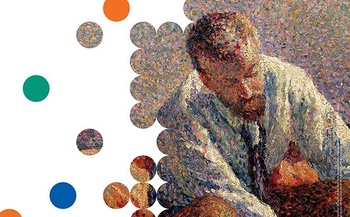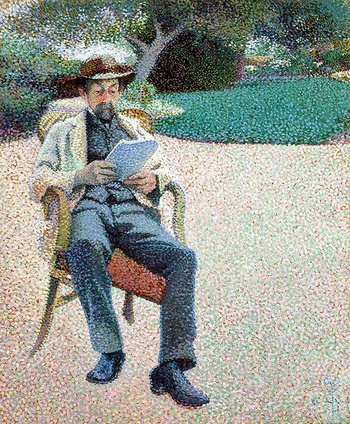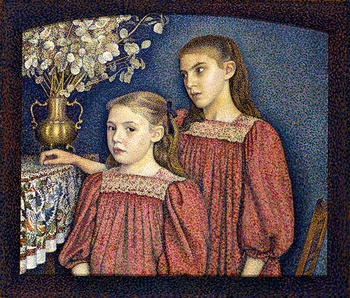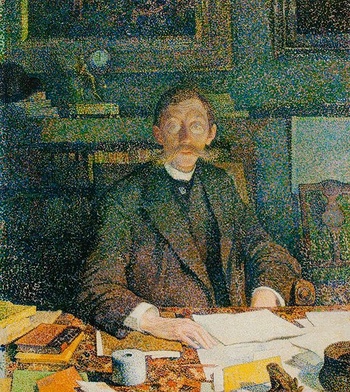To the Point: dotted with perfection

By systematically breaking down colour, neo-Impressionism opened up a new direction in painting. The "To the Point" exhibition presents a series of portraits by artists belonging to the movement, from the French pioneers – Seurat, Signac, Luce, etc. – to their Belgian heirs, including Van de Velde, Lemmen, and Van Rysselberghe.
Neo-Impressionism, pointillism, divisionism: a variety of terms (the first being the broadest) have been used to designate an artistic movement that radically changed the Impressionist approach by basing itself on scientific discoveries in the field of optics in relation to colour and light. Whereas Monet, Manet, Degas, and Renoir sought to convey a fleeting impression with considerable spontaneity in thick, vibrant strokes, the “neo” generation broke things down systematically, meticulously and patiently applying minuscule points as they followed to the letter the theories of Michel-Eugène Chevreul on complementary colours and “optical mixture”.
The twists and turns of history sometimes take strange directions: the work that initiated the movement, Un dimanche après-midi à l’île de la Grande Jatte by Georges Seurat, which was first exhibited in Paris in 1886, is now to be found at the Art Institute of Chicago. Even more remarkably, the Indianapolis Museum of Art possesses one of the finest collections of neo-Impressionist paintings, especially of the Belgian school. Some of those paintings are now back in Brussels, where they constitute the core of an exhibition that pays a particular tribute to three great masters with strong links to the Belgian capital: Henry Van de Velde, Georges Lemmen, and Théo Van Rysselberghe.
Neo-Impressionism, pointillism, divisionism: a variety of terms (the first being the broadest) have been used to designate an artistic movement that radically changed the Impressionist approach by basing itself on scientific discoveries in the field of optics in relation to colour and light. Whereas Monet, Manet, Degas, and Renoir sought to convey a fleeting impression with considerable spontaneity in thick, vibrant strokes, the “neo” generation broke things down systematically, meticulously and patiently applying minuscule points as they followed to the letter the theories of Michel-Eugène Chevreul on complementary colours and “optical mixture”.
The twists and turns of history sometimes take strange directions: the work that initiated the movement, Un dimanche après-midi à l’île de la Grande Jatte by Georges Seurat, which was first exhibited in Paris in 1886, is now to be found at the Art Institute of Chicago. Even more remarkably, the Indianapolis Museum of Art possesses one of the finest collections of neo-Impressionist paintings, especially of the Belgian school. Some of those paintings are now back in Brussels, where they constitute the core of an exhibition that pays a particular tribute to three great masters with strong links to the Belgian capital: Henry Van de Velde, Georges Lemmen, and Théo Van Rysselberghe.

Henry Van de Velde
He is represented in the brand new Musée Fin-de-Siècle Museum and the Jubelpark/Cinquantenaire Museum recently devoted a vast retrospective exhibition to him, on the occasion of the 150th anniversary of his birth. One of the pioneers of art nouveau architecture, a designer of genius, and the founder of La Cambre, Henry Van de Velde was also – and in the first place – a painter. A painter who, when he came across Seurat’s Grande Jatte at the exhibition staged by Les XX in Brussels in 1887, took to pointillism with a passion. As can be seen in the portrait, which was only shown once during the artist’s life, of Le Père Biart lisant au jardin (1890–91) and in three other paintings that flirt with Symbolism or even Pre-Raphaelitism.
Georges Lemmen
He is represented in the brand new Musée Fin-de-Siècle Museum and the Jubelpark/Cinquantenaire Museum recently devoted a vast retrospective exhibition to him, on the occasion of the 150th anniversary of his birth. One of the pioneers of art nouveau architecture, a designer of genius, and the founder of La Cambre, Henry Van de Velde was also – and in the first place – a painter. A painter who, when he came across Seurat’s Grande Jatte at the exhibition staged by Les XX in Brussels in 1887, took to pointillism with a passion. As can be seen in the portrait, which was only shown once during the artist’s life, of Le Père Biart lisant au jardin (1890–91) and in three other paintings that flirt with Symbolism or even Pre-Raphaelitism.
Georges Lemmen

The portrait of the Serruys sisters (1894) is the last portrait painted in a neo-Impressionist style by Georges Lemmen, a Brussels painter who was a member of the famous group known as Les XX. Within the extremely restrictive technique of pointillism, he succeeded in giving real depth to his two female subjects, far removed from the anonymous, interchangeable silhouettes of Seurat’s Grande Jatte or Une baignade à Asnières. In their dresses, touches of red blend subtly with the colour green in a perfect illustration of the theory of complementary colours. The superimposed points are continued beyond the canvas, invading the frame and thereby adding further depth to the painting.

Théo Van Rysselberghe
Of all the neo-Impressionist painters, the Belgian Théo Van Rysselberghe was probably the one who spent the longest time operating within this demanding movement, building up a wealthy clientele, both in Belgium and internationally, that kept him busy with commissions. The portrait of his friend the poet Émile Verhaeren (author of Les Campagnes hallucinées and Les Villes tentaculaires), his very first portrait of a man, which he painted in 1892, reminds us of the many links between leading figures in the arts. Among others, Van Rysselberghe also painted Maria Sèthe, wife of Henry Van de Velde, Irma Sèthe, a pupil of Eugène Ysaÿe, with her violin, and Claire Demolder, daughter of Félicien Rops. He also sculpted a bust of the writer and future Nobel prizewinner André Gide, who had a child by Van Rysselberghe’s daughter Elisabeth. This exhibition encourages us to plunge eagerly into this fertile crucible, a veritable golden age.
To the point - Le portrait néo-impressionniste 1886-1904 • > 18/5, 7/7, 10 > 18.00, wo/me/We 10 > 21.00, €3/4/5/6/8, ING Cultuurcentrum/Espace Culturel ING, Koningsplein 6 place Royale, Brussel/Bruxelles, 02-547.22.92, www.ing.be/art
Of all the neo-Impressionist painters, the Belgian Théo Van Rysselberghe was probably the one who spent the longest time operating within this demanding movement, building up a wealthy clientele, both in Belgium and internationally, that kept him busy with commissions. The portrait of his friend the poet Émile Verhaeren (author of Les Campagnes hallucinées and Les Villes tentaculaires), his very first portrait of a man, which he painted in 1892, reminds us of the many links between leading figures in the arts. Among others, Van Rysselberghe also painted Maria Sèthe, wife of Henry Van de Velde, Irma Sèthe, a pupil of Eugène Ysaÿe, with her violin, and Claire Demolder, daughter of Félicien Rops. He also sculpted a bust of the writer and future Nobel prizewinner André Gide, who had a child by Van Rysselberghe’s daughter Elisabeth. This exhibition encourages us to plunge eagerly into this fertile crucible, a veritable golden age.
To the point - Le portrait néo-impressionniste 1886-1904 • > 18/5, 7/7, 10 > 18.00, wo/me/We 10 > 21.00, €3/4/5/6/8, ING Cultuurcentrum/Espace Culturel ING, Koningsplein 6 place Royale, Brussel/Bruxelles, 02-547.22.92, www.ing.be/art
Read more about: Expo
Fijn dat je wil reageren. Wie reageert, gaat akkoord met onze huisregels. Hoe reageren via Disqus? Een woordje uitleg.